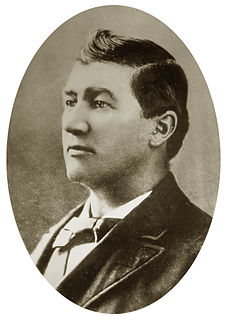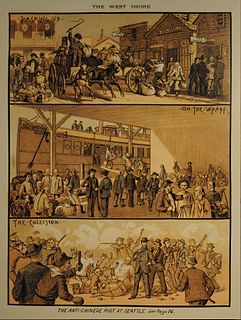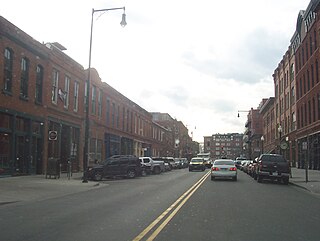
The Chinese Exclusion Act was a United States federal law signed by President Chester A. Arthur on May 6, 1882, prohibiting all immigration of Chinese laborers. Building on the earlier Page Act of 1875, which banned Chinese women from migrating to the United States, the Chinese Exclusion Act was the first – and remains the only – law to have been implemented to prevent all members of a specific ethnic or national group from immigrating to the United States.

The City of Golden is the home rule municipality that is the county seat of Jefferson County, Colorado, United States. The city population was 20,399 at the 2020 United States Census. Golden lies along Clear Creek at the base of the Front Range of the Rocky Mountains. Founded during the Pike's Peak Gold Rush on June 16, 1859, the mining camp was originally named Golden City in honor of Thomas L. Golden. Golden City served as the capital of the provisional Territory of Jefferson from 1860 to 1861, and capital of the official Territory of Colorado from 1862 to 1867. In 1867, the territorial capital was moved about 12 miles (19 km) east to Denver City. Golden is now a part of the Denver–Aurora–Lakewood, CO Metropolitan Statistical Area and the Front Range Urban Corridor.

A tong is a type of organization found among Chinese immigrants predominantly living in the United States, with smaller numbers in Canada, Australia and the United Kingdom. In Chinese, the word tong means "hall" or "gathering place". These organizations are described as secret societies or sworn brotherhoods and are often tied to criminal activity. In the 1990s, in most American Chinatowns, clearly marked tong halls could easily be found, many of which have had affiliations with Chinese organized crime.

The golden spike is the ceremonial 17.6-karat gold final spike driven by Leland Stanford to join the rails of the First Transcontinental Railroad across the United States connecting the Central Pacific Railroad from Sacramento and the Union Pacific Railroad from Omaha on May 10, 1869, at Promontory Summit, Utah Territory. The term last spike has been used to refer to one driven at the usually ceremonial completion of any new railroad construction projects, particularly those in which construction is undertaken from two disparate origins towards a common meeting point. The spike is now displayed in the Cantor Arts Center at Stanford University.
The Asiatic Exclusion League was an organization formed in the early 20th century in the United States and Canada that aimed to prevent immigration of people of Asian origin.

The Immigration Act of 1917 was a United States Act that aimed to restrict immigration by imposing literacy tests on immigrants, creating new categories of inadmissible persons, and barring immigration from the Asia-Pacific zone. The most sweeping immigration act the United States had passed until that time, it followed the Chinese Exclusion Act of 1882 in marking a turn toward nativism. The 1917 act governed immigration policy until it was amended by the Immigration Act of 1924; both acts were revised by the Immigration and Nationality Act of 1952.

Frank Chin is an American author and playwright. He is considered to be one of the pioneers of Asian-American theatre.

The history of Chinese Americans or the history of ethnic Chinese in the United States includes three major waves of Chinese immigration to the United States, beginning in the 19th century. Chinese immigrants in the 19th century worked as laborers, particularly on transcontinental railroads such as the Central Pacific Railroad. They came not only for the gold rush in California, but were also hired to help build the First Transcontinental Railroad. They also worked as laborers in mining and suffered racial discrimination at every level of society. Industrial employers were eager for this new and cheap labor. This resulted in many white people losing their jobs and were stirred to anger by the "yellow peril." Despite provisions for equal treatment of Chinese immigrants in the 1868 Burlingame Treaty, political and labor organizations rallied against immigrants of what they regarded as a degraded race and "cheap Chinese labor."

The Workingmen's Party of California (WPC) was an American labor organization, founded in 1877 and led by Denis Kearney, J.G Day, and H. L. Knight.

Chin Lin Sou was an influential leader in the Chinese American community and prominent figure in Colorado. He immigrated to the United States from Guangzhou, China, in 1859. Chin stood out amongst other Chinese immigrants at the time as he dressed like a westerner and spoke perfect English. He was a supervisor of hundreds of Chinese workers who built the transcontinental railroad and feeder lines across California, Utah, Nevada, Wyoming, and Colorado.

The Rock Springs massacre, also known as the Rock Springs Riot, occurred on September 2, 1885, in the present-day United States city of Rock Springs in Sweetwater County, Wyoming. The riot, and resulting massacre of immigrant Chinese miners by white immigrant miners, was the result of racial prejudice toward the Chinese miners, who were perceived to be taking jobs from the white miners. The Union Pacific Coal Department found it economically beneficial to give preference in hiring to Chinese miners, who were willing to work for lower wages than their white counterparts, angering the white miners. When the rioting ended, at least 28 Chinese miners were dead and 15 were injured. Rioters burned 78 Chinese homes, resulting in approximately US$150,000 in property damage.

The Seattle riot of 1886 occurred on February 6–9, 1886, in Seattle, Washington, amidst rising anti-Chinese sentiment caused by intense labor competition and in the context of an ongoing struggle between labor and capital in the Western United States. The dispute arose when a mob affiliated with a local Knights of Labor chapter formed small committees to carry out a forcible expulsion of all Chinese from the city. Violence erupted between the Knights of Labor rioters and federal troops ordered in by President Grover Cleveland. The incident resulted in the removal of over 200 Chinese civilians from Seattle and left two militia men and three rioters seriously injured.
This article contains a list of the Chinatowns which are either officially designated neighborhoods or historically important ones in the United States. Many of these Chinatowns were developed in the 1800s by members of the Chinese diaspora and have served as ethnic Chinese enclaves since then.

This is a bibliography of the U.S. State of Colorado.
The U.S. city of Tacoma, Washington was once home to a significant historic Chinatown. It was located in Downtown Tacoma near Railroad Street according to a historical record.
As of 2002, ethnic Chinese and Chinese American people comprise the second-largest Asian-origin ethnic group in the Wayne–Macomb–Oakland tri-county area in Metro Detroit. As of that year there were 16,829 ethnic Chinese, concentrated mainly in Troy, Rochester Hills, and Canton Township. As of 2012, Madison Heights also hosts a significant Chinese community.
As of 2012, 21.4% of the population in San Francisco was of Chinese descent, and there were at least 150,000 Chinese American residents. The Chinese are the largest Asian American subgroup in San Francisco. San Francisco has the highest percentage of residents of Chinese descent of any major U.S. city, and the second largest Chinese American population, after New York City. The San Francisco Area is 7.9% Chinese American, with many residents in Oakland and Santa Clara County. San Francisco's Chinese community has ancestry mainly from Guangdong province, China and Hong Kong, although there is a sizable population of ethnic Chinese with ancestry from other parts of mainland China and Taiwan as well.

Chinatown in Denver, Colorado, was a residential and business district of Chinese Americans in what is now the LoDo section of the city. It was also referred to as "Hop Alley," based upon a slang word for opium. The first Chinese resident of Denver was Hong Lee arrived in 1869 and lived in a shanty at Wazee and F Streets and ran a washing and ironing laundry business. More Chinese immigrants arrived in the town the following year. Men who had worked on the construction of the first transcontinental railroad or had been miners in California crossed over the Rocky Mountains after their work was completed or mines were depleted in California.
Chinese Americans in the Pacific Northwest have been around since as early as the 1850s. Chinese Americans arrived in the Greater Seattle area in as early as 1851. Oregon had also seen an influx of Chinese Immigrants as early as 1851, because of mining opportunities. Idaho saw an influx of Chinese Immigrants in the late-19th century, and by 1870 saw a population of around 4,000 Chinese immigrants. The influx of Chinese immigrants in the Pacific Northwest and the rest of the Western United States led to retaliation by whites, leading to anti-Chinese sentiment in the United States. These sentiment then led to the Chinese Exclusion Act of 1882, which expelled many Chinese Americans in the Pacific Northwest. Chinese exclusion is also driven by the failure of restriction. The United States had passed the Chinese Exclusion Act of 1882 to slow immigration, and mend Sinophobia in the west. However, the enforcement of the exclusion act was lackluster. The United States Department of Treasury had found itself with no money to enforce this law. Thus, nullifying the purpose of the exclusion act. Additionally, under the Chinese Exclusion Act of 1882, Chinese people could migrate to the United States if they were return immigrants. Consequently, Chinese immigrants began claiming that they were return immigrants so that they could work in the United States. This also made the Chinese Exclusion Act 1882 useless. This led the United States government to pass the Scott Act of 1888. This excluded all Chinese immigration because it was cheaper, and it appeased the racial tensions in the west.
Asian American activism broadly refers to the political movements and social justice activities involving Asian Americans. The general definition of activism is defined as "the activity of working to achieve political or social change, especially as a member of an organization with particular aims." The history of Asian American activism is important because according to Linh Dich, "Asians and Asian Americans.. . are often left out of political narratives, such as the Civil Rights movement, which prevents Asian and Asian Americans from being seen as a generative force for political rhetoric and change."















